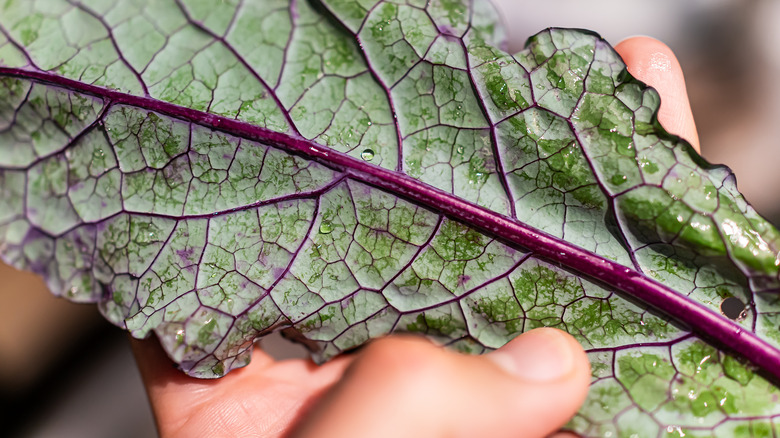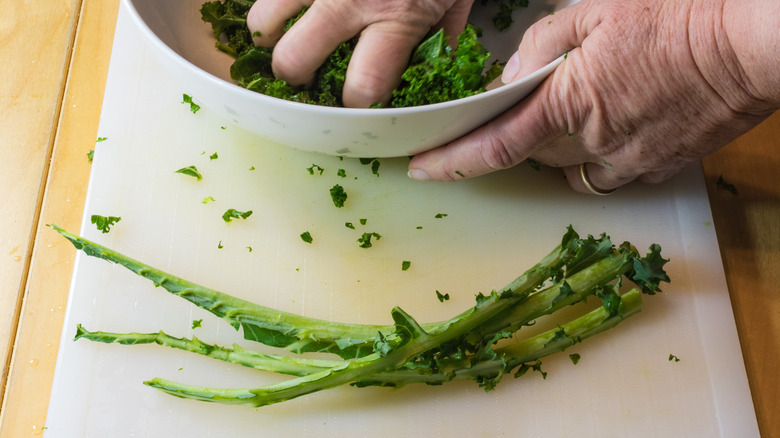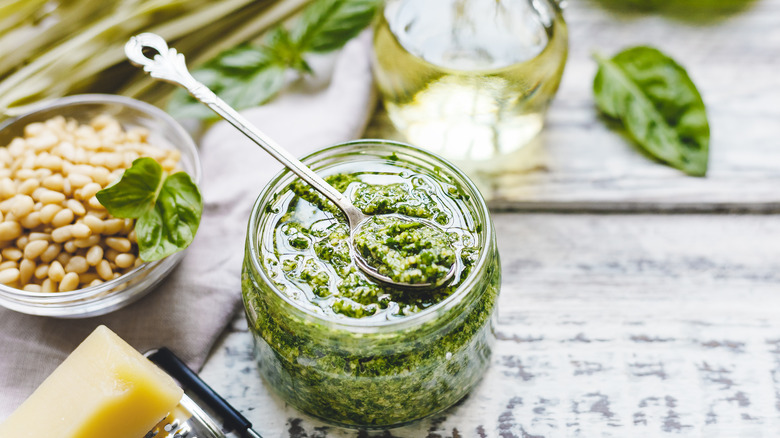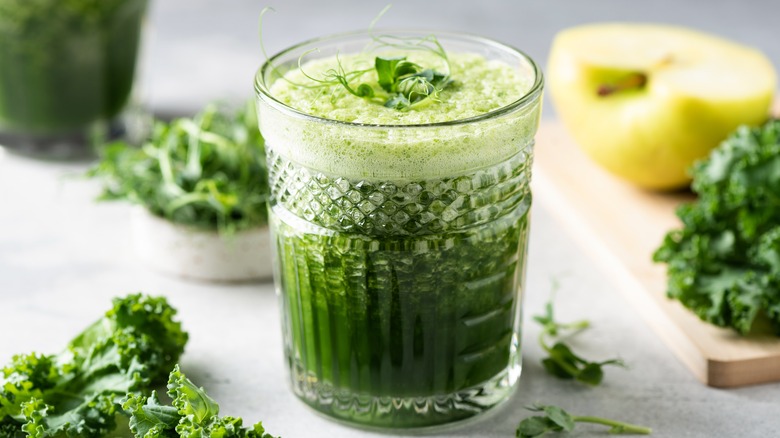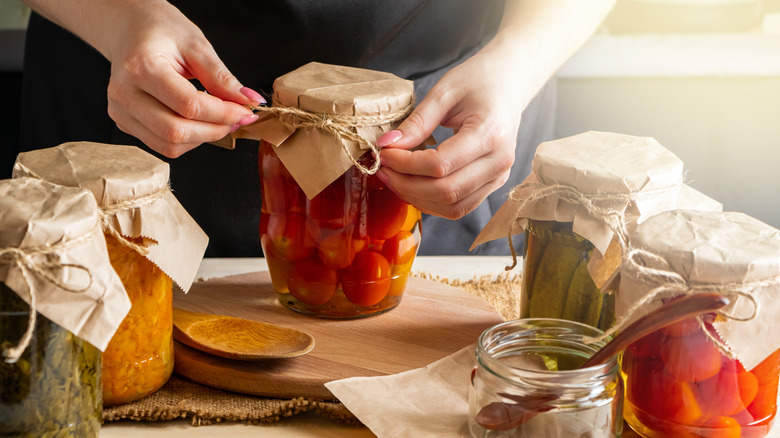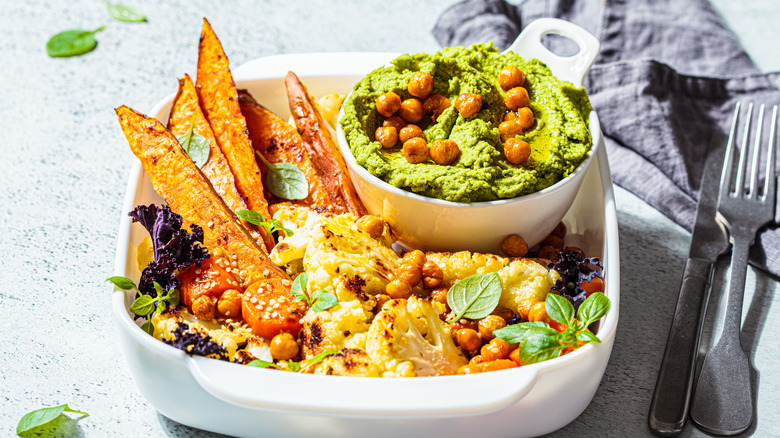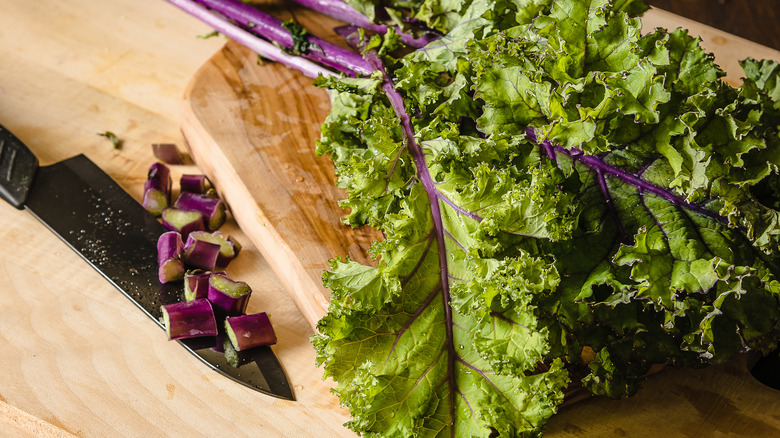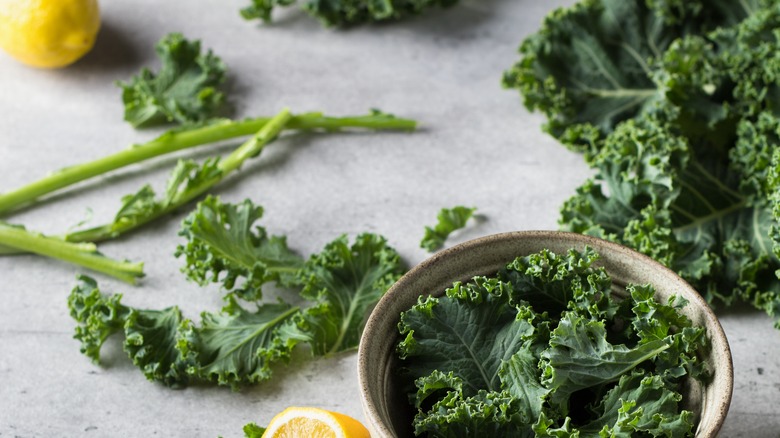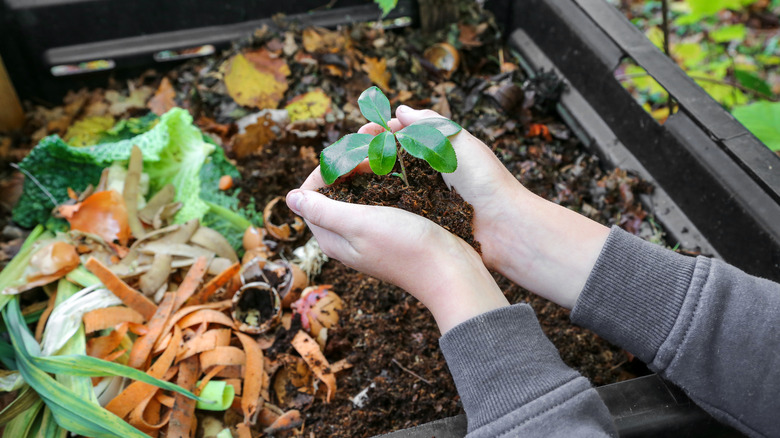14 Ways To Use Up Your Leftover Kale Stems
Kale has gone from parsley's rival garnish to America's trendiest leafy green in the short span of a few years. Much like its popular sidekick Brussels sprouts, kale can go from bitter and tough to tender and delicious depending simply on how it's prepared. Luckily, we've worked out the kinks and now this nutrient-power-packed and versatile veggie can be enjoyed in a variety of ways. Unknown to many, kale is more than just its leaves. If you're prepared to take it to the next level and get the most out of your harvest, consider its overlooked element: the leftover kale stems.
Kale in its entirety (stems included) is rich with nutrient-dense properties that aid in lowering cholesterol, creating a balanced gut microbiome, and reducing inflammation, per the National Library of Medicine.
While you may be familiar with a classic massaged kale salad, kale chips, or even kale smoothies, it may be time to elevate your kale-tastic culinary creations by using those leftover kale stems. Save them from their doom and use them to add nutrients, flavor, and texture to your dishes.
Make a crunchy salad topping
Kale's flagship dish is the ever-so-popular massaged kale salad. Unfortunately, the long fibrous kale stems can disrupt the otherwise enjoyable tender leaves. But that doesn't mean kale stems don't deserve a spot at the table, or even in your salad, for that matter.
After washing and spinning your kale leaves dry, use clean hands to tear away the leaves from the stem, while simultaneously ripping the leaves into small bite-sized pieces. Gently massage the leaves with a little olive oil to soften them until they turn a deeper shade of green. Use a sharp knife to dice the kale stem into pea-sized pieces, and sprinkle those pieces over your salad to add a crunchy texture. These smaller pieces will be much easier to chew and can enhance the textural diversity of your dish. Consider soaking the chopped kale stems in a little lemon juice or tamari before reintroducing them, to add bursts of salty or citrus flavor to your masterpiece.
Blend them into pestos or pasta sauce
Kale stems carry the same nutrients as their leaves, so to get the most bang for your buck, consider keeping them to use in your pasta sauces, like pesto. Pesto can be made from nearly any dark leafy green, and kale is no exception. Both the leaves and the stem can be blended with basil, or enjoyed as the featured lefty green in any pesto. Simply take your favorite fresh pesto recipe and add your chopped kale stems before blending. If you would prefer, use kale leaves and kale stems in place of basil, instead of in addition to it. Use the pesto spread on salads, pasta, and sandwiches.
Because kale stems carry a mild flavor, and when blended or cooked they lose their crunchy fibrous texture, they are worth keeping around. Even if you don't intend to use them right away, refrigerate the stems in a Tupperware or plastic baggie for over a week or until they begin to wilt. Consider chopping or blending kale stems into any olive oil, broth, tomato, or cream-based sauce as well. Kale stems pack a punch of nutrient-density, without compromising flavor.
Add a nutrient boost to soup
If you're an avid soupmaker, you know that almost any vegetable can be made into either a broth-based or creamy soup. While kale leaves are often found in white bean and vegetable soups, there is no limit to the different ways you can incorporate your favorite leafy green into bisques, stews, and curries. For a simple vegetable soup or a classic like chicken noodles, treat kale stems like you might celery. Simply chop your stems into bite-sized pieces and incorporate them into your soup before it's done cooking to allow the fibers to soften.
Cream of spinach, mushroom, squash, celery, and cauliflower soup are all fan favorites, so why not give our favorite new leafy green a chance? Grab your favorite cream of spinach soup recipe, and replace the spinach with whole kale leaves, stems included. Keep in mind that kale is tougher than spinach, so it may have to be blanched and blended for slightly longer. This works with practically any green soup recipe with spinach.
If you've used up your leaves and are looking to rid yourself of leftover kale stems, use a cream of a celery soup recipe and replace the celery with kale stems. Take note that celery contains natural sodium, so you may consider adding an extra pinch of sea salt if you take the kale stem route.
Drink them
Much like soups, smoothies don't discriminate based on fruit or veggie. While most people exclusively add the leafy part of kale to their blenders, it's important not to overlook the fiber and antioxidant-packed stems. This is perhaps one of the most resourceful and convenient ways to use kale stems because, after you separate the stems from the leaf, you can freeze the stems for up to three months. That means you can continuously add to your kale stem stash, and pull from it when you're craving a power-packed smoothie. And don't worry, the bitter flavor won't disrupt your drink as it's easily masked by the natural acids and sugars in fruit.
On the other hand, if you enjoy the flavor of kale, consider saving your kale stems and juicing them, either by themselves or along with other vegetables. Use a juicer, or blend your stems and veggies in a food processor and strain the liquid out using a cheesecloth or fine strainer.
Kale juice on its own carries important nutrient properties, and can even elevate the defense against bacteria, viruses, and toxins. In fact, consuming three or four shots of kale juice a day can lower bad cholesterol on par with one hour of daily exercise, per the National Library of Medicine.
Pickle them
Pickle enthusiasts know that this ancient practice doesn't stop with cucumbers and vinegar. Dilly beans, margarita pickles, pickled carrots, pickled beets, and pickled garlic just scrape the tip of the iceberg. For pickle pioneers, consider pickling kale stems for a tangy, salty, and crunchy treat.
Grab your favorite classic pickle recipe and replace cucumbers with kale stems. Consider adding complementary flavorings, like garlic, mustard seed, or sliced red onion to your brine. For a sweeter brine, include beets and red onion to give your pickled kale stems a bright red appearance and natural sweetness.
Pickled kale stems can be eaten on their own, or chopped and added to tacos, salads, sandwiches, and grain bowls. If you consider yourself an adventurous eater, consider using pickled kale stems to top pizza, burgers, or even loaded fries, or nachos. For avid brunchers, spice up a few classics by adding a few stems to your tried and true bloody mary recipe, or traditional eggs Benedict.
Blend them into dips
Who doesn't love dip? What about spinach and artichoke dip or hummus? Even your basic ranch or buffalo dip can be elevated in both nutrient content and flavor by adding the refreshing crunch of kale stems.
For a soft, hot appetizer like spinach or artichoke dip, consider pre-blanching finely chopped kale stems before incorporating them. For an even smoother texture found in creamy dips and hummus, try blanching and then blending the kale stems before mixing them in. While the deeply pigmented chlorophyll of kale leaves will turn any dish green, kale stems have a more subtle hue and are less likely to change the aesthetic of your dip.
For a cold dip like ranch, french onion, or chickpea buffalo, consider leaving the kale stems raw. Finely chop them, and mix them in to add a bit of crunch. As dips are not typically known for their healthy properties, this added nutrient boost will come as a pleasant surprise to your body.
Sauté or grill kale stems
Enter, your new favorite side dish. Much like green beans or asparagus, kale stems taste delicious sauteed in a little olive oil with garlic, lemon, pepper, and a dash of salt or tamari.
After washing and stemming the kale, cut the stem into matchstick-length pieces using a sharp knife. Heat your pan with a little olive oil, and follow any green bean recipe you're familiar with. If your favorite side dish is teriyaki green beans with sesame seeds, give kale stems a chance to step in and shine. If you prefer just a dash of lemon juice and pepper, enjoy the natural flavors of the stem. Be sure to cook the stem long enough so that it is no longer fibrous and can be chewed easily.
For grill masters, you may have struggled to keep thin veggies like asparagus from falling to their firey doom. Use a vegetable basket or grill with a wooden plank when grilling kale stems, and season them as you would any grilled veggie.
Add texture to your tacos
The perfect taco includes a range of textures from creamy to crunchy. When working with soft tacos, it's easy to forget about incorporating the crunch. Simply use finely dived raw kale stems as a garnish, or mix them with any creamy sauce along with diced onion, minced garlic, lime juice, and sriracha or chipotle. Kale stems blend in beautifully with creamy salsa verde. This unique superfood topping can bring your taco or burrito bar to the next level.
In contrast, sautéed kale stems can be the featured ingredient of your Mexican dish. Just sauté chopped stems in a little oil with garlic powder, cumin, chili powder, and tamari. Cook until the stem is no longer fibrous and chewy and load into your taco or burrito shell. Kale stems can also be cooked in enchilada sauce, or spiced with your favorite taco seasoning to make a warm, spicy, and nutrient-dense meat replacement.
Air fry or bake them
Healthy snacks that hit the spot are difficult to come by. They are often loaded with sunflower oil, high levels of sodium, refined sugars, and preservatives. That being said, who can resist the crunch of a chip, or a spoonful of ice chocolate cream? Since we are only human, it's helpful to set yourself up for success with a few tasty go-to snacks that are actually good for you.
Much like kale chips, leftover kale stems can get crispy when baked or air fried. Although they won't reach that same crispy chip texture as air-fried kale chips, the stems have their own unique texture. Toss the cut stems in a little oil, then corn starch and seasoning before adding them to your high-temperature cooker. Enjoy them as a snack, or use them to elevate the aesthetic of your main dish.
Try crossing two cooked and seasoned stems over braised salmon or grilled fillet. Incorporate them into a polenta or risotto dish. Even poke them into a bed of mashed potatoes for your little one. The possibilities are endless.
Dip them
Much like the increased popularity of cruciferous vegetables like kale, cauliflower, and Brussels sprouts, zucchini is taking a front seat and we're here for it. Zucchini fries are emerging in anywhere from high-end restaurants to your local dive bar, and they are worth the hype. If you're a fan of zucchini fries or the Indian dish vegetable pakora then it's time to give kale stem fries the chance they deserve.
After washing and removing the kale leaves, chop the stems in half to make them shorter. Use a frying, baking, or chickpea batter to coat the stems, and roast them in the oven at a high temperature until they are crispy and begin to brown. When in doubt, follow a zucchini fry recipe and swap out the featured veggie. A quick and easy way to make kale stem fries irresistible is to toss them in truffle oil, parmesan cheese, and chopped parsley.
Enjoy your nutrient-dense snack dipped in a simple homemade garlic aioli or even good ol' ketchup.
Save them to make veggie stock
Homemade vegetable stock is simple to make, and is a great way to use leftover vegetable scraps. Each time you find yourself with a handful of onion skins, carrot peels, pepper tops, or leftover kale stems, save them in a baggie or Tupperware in your freezer. Once you have a full bag, boil them in water along with your favorite seasonings and a tablespoon of tomato paste. The longer the mixture simmers, the better! Add a tablespoon of olive oil for a richer mouthfeel, or omit oil for a fat-free broth. Once you're ready to remove the broth from the stovetop, strain out and compost the remaining solids.
Kale stems will add an unmatched element of nutrient density to your broth, infusing any recipe it goes into with vitamins and antioxidants.
Bored of your standard run-of-the-mill vegetable broth? Learn how to make corn stock using corn cobs, and, of course, kale stems. Never throw away vegetable scraps again.
Add to your stir fry
Grab your wok and fire up those burners, because you're about to up your vegetable stir fry recipe game significantly with the addition of leftover kale stems. Because of their fibrous nature, when cooked, they easily absorb and retain sauces and spices.
For your classic brown sauce stir fry, consider cutting kale stems into match stick-length pieces, or chop them smaller like a green onion. Introduce them in the hot pan after some of the firmer vegetables like carrots or onions, but before your leafy greens like bok choy. They are exceptionally delicious when added to fried rice dishes and noodle dishes, always packing a punch of moisture and flavor.
In contrast, sprinkling raw, finely chopped kale stems on your masterpiece as a garnish will give your dish a refreshing watery crunch like watercress or celery. This can be a useful tool when serving a salty or heavy stir fry to break up the intensity of flavor.
Enhance your ramen
For many Americans, ramen used to mean salty instant noodles for college dorms and short lunch breaks served in styrofoam cups. Now, gastropubs across the country have taken a few notes from Japanese culture and started serving it the right way: loaded with meat, vegetables, and that flagship soft-boiled egg. This ramen boom is catching fire, per The New Yorker, and we're here for it.
Kale stems can be used in one of three ways when entering the ramen game. They can be cut up into long pieces and cooked into the broth in order to break down the fibrous stem. Much like bok choy, kale stems can offer a crunchy and mild relief from the salty and sometimes oily broth. In addition, small diced raw kale stems can be used as a crunchy garnish alongside green onion and toasted sesame seeds.
For those who prefer a slightly thicker broth, blanched kale stems can be blended with the liquid. This hidden nutrient boost will go undetected in your culinary creation.
Compost them
If you're guilty of leaving veggies to wilt in the back of your fridge, you're not alone. Luckily, kale is relatively easy to bring back to life. Soak kale in ice water and seal it in plastic before putting it back in the refrigerator overnight. By morning, your kale will have likely perked up. Oftentimes, even if your kale leaves are wilted, the stems may be healthy enough to save. If this doesn't work and you're unable to enjoy kale stems, that doesn't mean your garden can't!
When in doubt, when all hope of repurposing kale stems is lost, compost them. While the leafy portion of kale breaks down rather quickly, the stems take quite a bit longer. To speed along the process, chop them up before adding them to your compost bin. Because they are rich in nitrogen, they will contribute greatly to the quality of the compost you're producing for your garden. To balance your compost, mix the stems with cardboard, eggshells, newspaper, or straw, per Can I Compost This?
